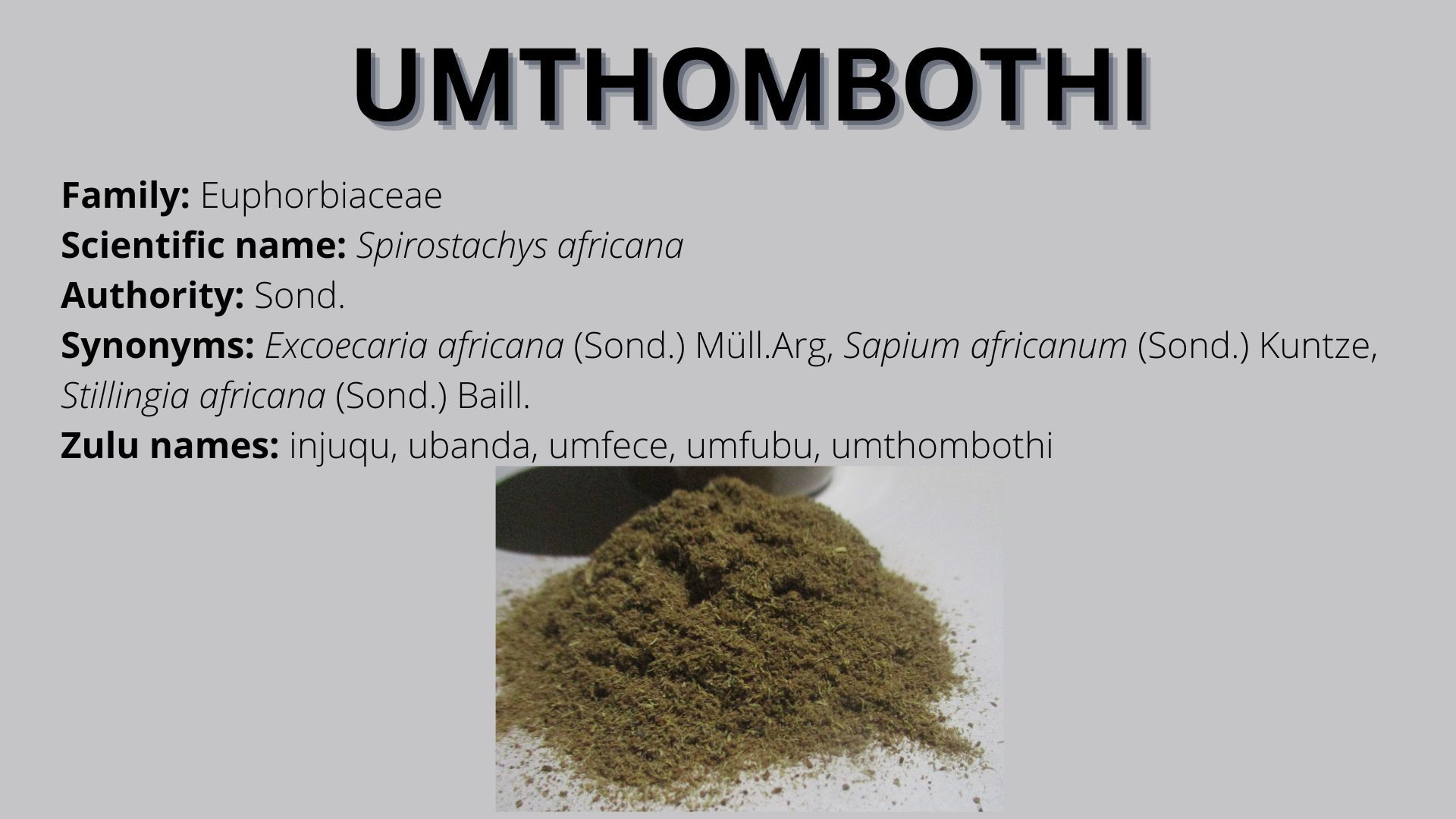Family: Euphorbiaceae
Scientific name: Spirostachys africana
Authority: Sond.
Synonyms: Excoecaria africana (Sond.) Müll.Arg, Sapium africanum (Sond.) Kuntze, Stillingia africana (Sond.) Baill.
Zulu names: injuqu, ubanda, umfece, umfubu, umthombothi
Other names: African mahogany, African sandalwood, Cape sandalwood, headache tree, jumping bean tree, tamboti (English) agelhout, gifboom, melkhout, sandalbeen, sandelhout, tambotie, tambotiebeen (Afrikaans)
Description: S. africana is a medium-sized deciduous tree that grows in the woodland and valley bushveld, often found in dense stands and near water. It has elliptic leaves with finely toothed margins, a milky latex, yellow (male) and red (female) flowers borne separately on the same tree, and fruits in the form of three-lobed capsules.
The milky latex secreted by the plant is extremely toxic; contact causes acute irritation of the skin and pain and damage to the eyes. One drop of latex results in purging and vomiting; cow’s milk is reportedly an effective antidote to irritations caused by the latex and sap. When the wood is burned it gives off a sweet odour that can cause headaches, nausea, and diarrhoea.
It’s been speculated that S. africana is the “algum” wood from “Ophir” that Hiram, king of Tyre, sent to king Solomon to build the Temple and the Palace in 2nd Chron. 2:7.
Uses
Bark
- The bark is used to make a decoction tonic to promote weight loss.
- The bark is used to treat constipation, stomach ache, stomach ulcers, acute gastritis, diarrhoea, and dysentery. The powdered bark decoction is taken for stomach ulcers. The decoction is also used to make soft porridge oats that is taken three times daily on an empty stomach. The powdered bark is mixed with that of Trichilia emetica, and boiled for 10 minutes, to treat constipation.
- The plant is used to treat idliso.
- The dry bark is used in embrocation for rashes in babies.
- The bark is mixed with that of Dalbergia armata to treat lice infestation.
- The bark is ground to powder that is used to treat snakebite.
- The bark is used as hunting poison.
- The roots and bark are used to make an infusion that is used as eye washes.
- The plant is used to make uzifozonke, a tonic to treat all ailments.
Latex
- The latex and bark are used as a purgative and an emetic agent.
- The latex is applied to boils.
- The latex is used to treat toothache.
- The latex is used on cattle sores to kill maggots.
Wood
- The wood is used to build huts and make fence poles.
- The wood is used to make necklaces, gunstocks, and walking sticks.
- The smoke from burning wood is used to fumigate huts against wood-boring insects.
- The smoke is also used to drive away bad spirits.
- The wood is used as insect repellent.
- The wood is used to make arrows for hunting.
- The freshly cut branches used to find stingless bee nests. Bees are attracted to the latex.
- The slightly burnt wood is put in the nose to relieve headaches.
- The wood is used to make a charm that Xhosa and Mpondo people wear.
Reference and further reading:
- Boon, R. 2010. Pooley’s trees of eastern of South Africa: A complete guide, second edition. Flora and Fauna Publications, Durban.
- Corrigan, B.M., Van Wyk, B.E., Geldenhuys, C.J. and Jardine, J.M. 2011. Ethnobotanical plant uses in the KwaNibela Peninsula, St Lucia, South Africa. South African Journal of Botany 77, pp.346–359.
- Hutchings, A., Scott, A.H., Lewis, G. and Cunningham, A. 1996. Zulu medicinal plants. Natal University Press, Pietermaritzburg.
- Lennox, S.J. and Bamford, M., 2015. Use of wood anatomy to identify poisonous plants: Charcoal of Spirostachys africana. South African Journal of Science, 111(3-4), pp.1-9.
- Mabogo., D.E.N. 1990. The ethnobotany of the VhaVenda. M.Sc. dissertation, University of Pretoria, Pretoria.
- Mathabe, M.C., Hussein, A.A., Nikolova, R.V., Basson, A.E., Meyer, J.M. and Lall, N., 2008. Antibacterial activities and cytotoxicity of terpenoids isolated from Spirostachys africana. Journal of ethnopharmacology, 116(1), pp.194-197.
- Munkombwe, N.M., Duri, Z.J., Hughes, N.A., Maswabi, T., Leketo, M.B. and Dijogadifele, O.D., 2006, July. Spirostachys Africana–The Latex Content. In Proceedings from the 2 nd International Conference on Appropriate Technology (p. 10).
- Palmer, E. and Pitman, N. 1972b. Trees of southern Africa Vol.2. Balkema, Cape Town.
- Pujol, J. 1990. Natur Africa: The Herbalist handbook. Lean Pujol Natural Healers Foundation, Durban.
- Van Wyk, B.E. and Gericke, N., 2000. People’s plants. A guide to useful plants of southern Africa. Briza Publications, Pretoria.
- Watt, J.M. and Breyer-Brandwijk, M.G. 1962. Medicinal and poisonous plants of southern and eastern Africa, second edition. Livingstone, London.
